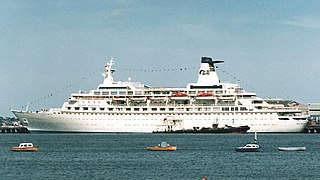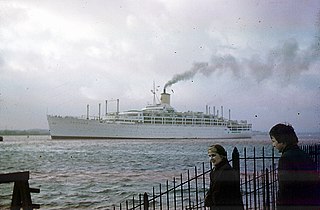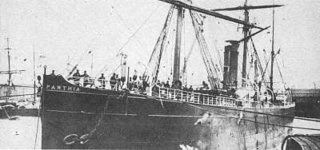
The St. Lawrence Seaway is a system of locks, canals, and channels in Canada and the United States that permits oceangoing vessels to travel from the Atlantic Ocean to the Great Lakes of North America, as far inland as Duluth, Minnesota, at the western end of Lake Superior. The seaway is named for the St. Lawrence River, which flows from Lake Ontario to the Atlantic Ocean. Legally, the seaway extends from Montreal, Quebec, to Lake Erie, and includes the Welland Canal. Ships from the Atlantic Ocean are able to reach ports in all five of the Great Lakes, via the Great Lakes Waterway.

Queen Elizabeth 2 (QE2) is a retired British passenger ship converted into a floating hotel. Originally built for the Cunard Line, the ship was operated by Cunard as both a transatlantic liner and a cruise ship from 1969 to 2008. She was then laid up until converted and since 18 April 2018 has been operating as a floating hotel in Dubai.

An ocean liner is a type of passenger ship primarily used for transportation across seas or oceans. Ocean liners may also carry cargo or mail, and may sometimes be used for other purposes. Only one ocean liner remains in service today.

RMS Caronia was a 34,183 gross register tons (GRT) passenger ship of the Cunard Line. Launched on 30 October 1947, she served with Cunard until 1967. She was nicknamed the "Green Goddess" after her light green hull livery. She was one of the first "dual-purpose" ships, built both for 2-class transatlantic crossings and all 1st-class cruising. After leaving Cunard she was briefly Caribia in 1969, after which she was laid up in New York until 1974, when she was sold for scrap. While being towed to Taiwan for scrapping, she was caught in a storm on 12 August. After her tow lines were cut, she repeatedly crashed on the rocky breakwater outside Apra Harbor, Guam and broke into three sections.

Laconia was a Cunard ocean liner, built by Swan, Hunter & Wigham Richardson as a successor of the 1911–1917 Laconia. The new ship was launched on 9 April 1921, and made her maiden voyage on 25 May 1922 from Southampton to New York City. At the outbreak of the Second World War she was converted into an armed merchant cruiser, and later a troopship. She was sunk in the South Atlantic Ocean on 12 September 1942 by torpedoes. Like her predecessor, sunk during the First World War, this Laconia was also destroyed by a German submarine. Some estimates of the death toll have suggested that over 1,658 people were killed when the Laconia sank. The U-boat commander Werner Hartenstein then staged a dramatic effort to rescue the passengers and the crew of Laconia, which involved additional German U-boats and became known as the Laconia incident.

Lake freighters, or lakers, are bulk carrier vessels that operate on the Great Lakes of North America. These vessels are traditionally called boats, although classified as ships.

MS Song of Norway was one of the first ships purpose-built as a cruise ship. She was the first ship of Royal Caribbean International when she entered operation in 1970. She was sold for scrap in 2013 and broken up in 2014, after serving her last years as a gambling ship.

The MV Discovery was a cruise ship, which was formerly operated by Voyages of Discovery and was last in service for Cruise & Maritime Voyages. She was scrapped in Alang, India as Amen in 2014.

RMS Sylvania was an ocean liner built in 1957 by John Brown & Co (Clydebank), in Glasgow, for the United Kingdom-based shipping company Cunard Line. She was the last Cunard Line vessel built specifically for transatlantic crossings. The ship was later heavily rebuilt as a cruise ship, and sailed under the names SS Fairwind, SS Sitmar Fairwind, SS Dawn Princess and SS Albatros before being scrapped in 2004. She was renamed SS Genoa for her last voyage.
Port Weller Dry Docks was a shipbuilder on the Welland Canal at the Lake Ontario entrance. The shipbuilder was founded in 1946 and the site was initially owned by the Government of Canada for storage purchases. The shipyard expanded to include ship repair, and reconstruction work. In 1956, the drydock was sold to the Upper Lakes Shipping Company, which began the construction of vessels at the site. The shipyard twice went insolvent, most recently in 2015. Port Weller Dry Docks was used to build, refit and repair cargo vessels.

Empress of Canada was an ocean liner launched in 1960 and completed the following year by Vickers-Armstrongs of Walker, Newcastle upon Tyne, England for Canadian Pacific Steamships Ltd. This ship, the third CP vessel to be named Empress of Canada, regularly traversed the transatlantic route between Liverpool and Canada for the next decade. Although Canadian Pacific Railways was incorporated in Canada, the Atlantic liners were owned and operated by the British registered subsidiary Canadian Pacific Steamships Ltd. and were always British flagged and manned and therefore Empress of Canada was not the flagship of the Canadian Merchant Marine.

SS Orcades was an ocean liner serving primarily the UK – Australia – New Zealand route. She started service as a British Royal Mail Ship (RMS) carrying first and tourist class passengers. Orcades carried many migrants to Australia and New Zealand and was later used as a cruise ship, and is featured in the British Pathe films "I am a passenger" on YouTube. She also made several voyages from Canada (Vancouver). "Orcades" is the Latin name for the Orkney Islands.
American Classic Voyages was an American-based cruise ship holding company cruise line, headquartered in Chicago, that operated between 1993 and 2001. The company attempted to take advantage of federal loans and other incentives to build and grow a US-flagged passenger ship industry. The company traded on the Nasdaq Stock Market under the ticker symbol "AMCV". The company operated the Delta Steamboat Company, Delta Queen Coastal Voyages, American Hawaii Cruises and United States Lines.

SS Parthia (1870–1956) was an iron-hulled transatlantic ocean liner built for the Cunard Line by William Denny and Brothers in Dumbarton, Scotland. Her sister ships were the Abyssinia and Algeria. Unlike her two sisters, Parthia was smaller, built in a different shipyard and had a slightly different funnel arrangement. The Parthia was retired by Cunard in 1883 and sold to John Elder & Co., who subsequently transferred her to the Guion Line. After serving with the Guion Line and operating on trans-Pacific routes with the Canadian Pacific Railway Company, she was refitted and renamed Victoria.

Pineglen was a bulk carrier owned and operated by Canada Steamship Lines. She was built at the Collingwood Shipyards, in Collingwood, Ontario in 1985, to a single superstructure lake freighter design. Initially named Paterson, the vessel was sold to Canada Steamship Lines in 2002 and renamed. Unlike more modern lake freighters she was built to a "straight-deck" design – i.e. she was not equipped with a self-unloading boom. The vessel was sold for scrap in 2017.

CSL Tadoussac is a lake freighter currently operated by Canada Steamship Lines (CSL) on the Great Lakes. She was launched in 1969. Initially named Tadoussac, following her refit in 2001, she was renamed CSL Tadoussac She was the last freighter built for CSL in the traditional two superstructure design, which puts her bridge up in the ship's bow. The vessel primarily transports iron ore and coal.

Tundra is a bulk carrier. She was launched in 2009. The maritime site boatnerd reports she is operated by Navarone SA of Limassol, Cyprus, and leased to Canfornav Incorporated of Montreal, the Canadian Forest Navigation Group. Marine Link however reports that she is owned by Canfornav.
The Eisenhower Lock is one of the seven canal locks on the St Lawrence River leg of the St Lawrence Seaway. This lock provides a 38 foot lift for ships heading upstream. It is one of two locks located near Massena, New York.

Pearl Mist is a small cruise ship, built in Halifax, Nova Scotia. After her completion, years of legal dispute delayed her being put into operation, and she did not leave on her inaugural voyage until June 2014. She is currently operated by Pearl Seas Cruises.
















